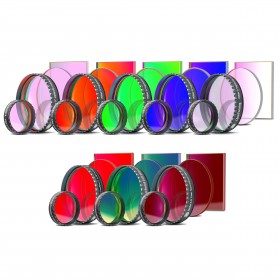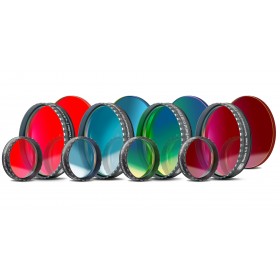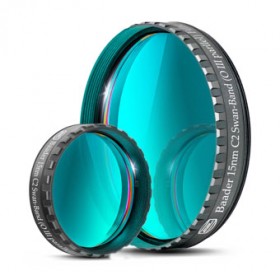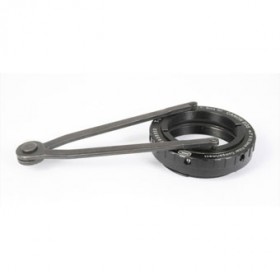New f/3 Ultra-Highspeed (Ultra-Narrowband) Filter Category
During the last couple of months after introducing our new CMOS-optimized filter families, we have received lots of positive feedback from our customers.
However, there was an increasing number of reports and long discussions about low signal, halo strength and so on, which showed more and more, that the complexity of this topic needs a really detailed explanation. Especially when going to the physical limits, like with our Ultra-Narrowband (UNB) filters, there is no standard solution for every user with different telescopes, sky and weather conditions
This situation was intensified because the f/2 Ultra-Highspeed filter category especially needs a more selective categorization, in order to select filters with the correct PRESHIFT, to comply with the f/ratio and the amount of obstruction of the respective telescope optics.
Until some weeks ago most users received filters which worked very well for them, while some others received the same filters – but they worked poorly on their scope. It took us some time to prepare the necessary insight and knowledge base on how to select filters matched for the many different f/ratios, as well as the different levels of secondary obstruction in case of catadioptrics and newtonians.
Kindly take the time to follow through with us and learn what has not been explained anywhere decently until now:
Preshift – what is it ?

Whitepaper: Narrowband Filters on Astronomical Telescopes
The theory explained in short
When working with f/2 (to a lesser degree also with f/3 and longer focal lengths), incoming angles of light will cross any filter with an inclination from 0° to a maximum of 14° with f/2 telescope optics. This requires the bandpass of Highspeed-dedicated Narrowband filters to be red-shifted by 1 nm to 2,5 nm, depending on the optical parameters of the telescope. Most filter suppliers simply do not preshift their filters peak wavelength at all and customers always receive a filter that is produced "straight on band". This will work well for most telescopes as long as the filter FWHM stays wide and the f/ratio stays well above f/3.4 and only if the telescope optics has zero central-obstruction. But downwards of < f/4 and in conjunction with increasing obstruction of faster optical telescopes, nothing is "on band" anymore, since the transmitted wavefront experiences an ever increasing "blue-shift" – as mentioned, depending on the f/ratio and the amount of obstruction. Without compensating this inevitable blue-shift by a suitable red-preshift, a 95% peak-transmission filter may mutate into a 30% transmission filter. For this reason we always did differentiate between regular narrowbands without preshift and highspeed filters featuring a preshift, in order to provide maximum filter transmission for the wide range of telescope f/ratios.
So far filter manufacturers did not offer information on the necessity of preshifting narrowband filters at all (very few do offer preshifted filters "on special demand" – at high cost). From a manufacturers perspective this might be somewhat understandable as it requires stocking a multitude of different filter sizes and different filter families for different telescope optics, each filter category redshifted differently by a closely defined degree. And in order to make things even more difficult, even temperature shift needs to be considered to a minor degree. For instance, under actual imaging conditions in a winter night at - 20°C, the same filter will have a slightly different shifted transmission window than when used in the lab at +20°C. This will remain insignificant for long focal length optics but becomes increasingly relevant with faster optics. For this reason, below we do show the different temperature filter shift behaviour for temperature ranges from -20°C to +20°C in three separate graphs.
Now finally, all of the above is explained in necessary detail and with explaining graphs in a 24 page whitepaper
If you want to dig into the subject of narrowband filter shift, we ask you to please study it carefully.
The problem identified
Example: H-alpha 3.5nm Ultra-Narrowband/Highspeed Filter Selector Graph
Usually for O III (and S II) a signal strength similar to H-alpha is expected/hoped for, but this is limited by physics. Equalizing signal strength of narrowband O III / S II data to those gained at H-alpha always requires longer or more exposures than in H-alpha, owing to much less energy supplied by O III and S II nebula emission lines. Hard stretching of insufficient depth of data will certainly bring out halos. It is the main reason why there is seldom any halo complaint for H-alpha-filters, compared to O III and S II filters. This fact led us to not listen closely enough when feedback occurred concerning insufficient signal – mostly concerning the Highspeed-Version of Ultra-Narrowband filters used at fast optics.
Example: OIII 4nm Ultra-Narrowband/Highspeed Filter Selector Graph
Actually we were convinced to be already doing good to the astro community by offering preshifted filters at all, in the form of a f/2 highspeed filter category, while keeping prices for such small and dedicated production runs well within affordable limits. For many years we offered f/2 highspeed-filters that work very well, while having slightly wider passbands than the current 6.5 nm f/2 Highspeed filters. Both our current 6.5 nm CMOS-optimized highspeed filters as well as the former CCD-highspeed filters have been produced with a preshift to serve a telescope f-range from f/3.4 down to f/1.8. This works well for filter FWHM-passbands as narrow as 6.5 nm (see the detailed explanations in the whitepaper linked above), but it was not decently explained until now about how to select between regular narrowband versus highspeed-narrowband filters – which has caused difficulties for users to differentiate between the two, with some users ending up with a filter providing less signal than expected. For this reason the two different 6.5nm Narrowband/Highspeed filter categories have also been included in our selector below.
But what still does work well with only two filter categories at FWHM of 6.5 nm (Narrowband and f/2 Highspeed) we had to learn does not work as well with FWHM 3.5 nm and 4 nm filters. At such even narrower filter passbands as 3.5 and 4 nm, the two so far available filter families of Ultra-Narrowbands and f/2 Ultra-Highspeeds did not make it possible to match filters perfectly to the users telescope(s) in the f/range from f/3.4 down to f/2.3. So in case your telescope optics does work inside that f-range of faster than f/3.4, respectively slower than f/2.3, chances are that you were supplied with the wrong 3.5/4 nm filter preshift and rightfully report about low filter transmission. For all other f/ratios the decision between Ultra-Narrowband or f/2 Ultra-Highspeed does work well and here we got only very few feedback on signal loss.
Example: SII 4nm Ultra-Narrowband/Highspeed Filter Selector Graph
It took us some time to find that the cause of reports concerning low signal and halos does come almost entirely from people having bought an f/2 declared Ultra-Highspeed filter – but using it in the range of f/2.3 to f/3.4. Or people having bought a 3.5/4 nm Ultra-Narrowband filter but using it with optics below f/3.4.
This situation had caused us to stop filter deliveries in recent weeks and use the time to redo our filter categorization on the 3.5/4 nm Ultra-Narrowband / Ultra-Highspeed Filters into three distinctive categories
- Changed working range:
3.5/4nm f/2 Ultra-Highspeed, with preshift exclusively for telescope optics faster than f/2.3 (formerly declared from f/3.4 to f/1.8)
- NEW:
3.5/4nm f/3 Ultra-Highspeed, with preshift exclusively for telescope optics ranging from f/2.3 to f/3.4
- Unchanged:
3.5/4nm Ultra-Narrowband, without preshift – for telescope optics slower than f/3.4
The selector tool shown below will make it easy for you or your dealer to identify the most suitable filter category for your telescope or your range of telescopes. It quickly becomes obvious that choosing filters in the wider passband of 6.5 nm will cover a wider range of optics and be more affordable at the same time. These are very good "bread&butter"-filters.
However, there is a reason to decide for one of the (now) three Ultra-Narrowband/Highspeed categories. Mostly when you must work under bright skies in or in the vincinity of a city or other heavy light pollution. In general a sky brightness above Bortle 7 absolutely justifies to use a 3.5/4 nm filter that has ~ 1.4x better contrast than the otherwise similar 6.5 nm filter.
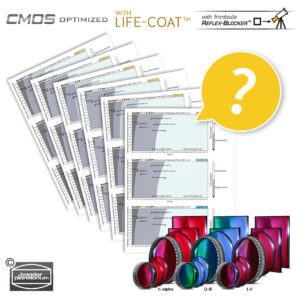
Baader Narrowband-/Highspeed Filter Selector
People with f/3.4 down to f/2.3 telescopes that have problems with obtaining decent signal are invited to contact us so it can be decided if a refund or exchange is suitable, or if there are other solutions/advice at hand.
Baader Narrowband-/Highspeed Filter Selector
To make it easy for you in the future to decide which kind of Highspeed (or Narrowband) filter you need for your telescope, please check the new selector tool that provides you the correct individual graph based on your entries. In general please note that there are multiple factors to take into account when selecting a (Ultra-)Narrowband/Highspeed filter:
- The aperture ratio (f/#) as well as the desired FWHM (6.5nm or 3.5/4nm)
- Vignetting (central-obstruction in %) of the optical system greatly influences filter blue shift and needs to be put into the graph, in order to find the best suited filter
- Temperature shift: whatever you measure in a warm lab at 20°C, at -20°C it will shift into blue by about 0.4 nm to a maximum of ~1 nm. So the average temperature of your observation site ought to be taken into account, mostly when selecting (Ultra-)Narrowband/Highspeed filters
Thank you for reading and for your consideration.










